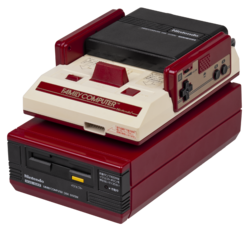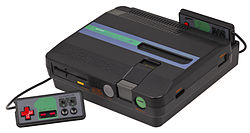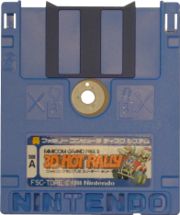- Family Computer Disk System
-
Family Computer Disk System Manufacturer Nintendo Generation Third generation (8-bit era) Retail availability - JP February 21, 1986
Media Floppy disksb[›] CPU Ricoh 2A03 8-bit processor (MOS Technology 6502 core) Best-selling game Super Mario Bros.: The Lost Levels The Family Computer Disk System (ファミリーコンピュータ ディスクシステム Famirī Konpyūta Disuku Shisutemu, sometimes abbreviated as the Famicom Disk System, the Disk System, or simply the FDS) was released on February 21, 1986 by Nintendo as a peripheral for the Family Computer ("Famicom") console in Japan. It was a unit that used proprietary floppy disks (called "Disk Cards") for data storage. It was announced, but never released, for the North American Nintendo Entertainment System. Through its entire production span, 1986–2003, 4.44 million units were sold.
The device was connected to the Famicom deck by plugging a modified cartridge known as the RAM Adapter into the system's cartridge port, which attached via a supplied cable to the disk drive. The RAM adapter contained 32 kilobytes (KB) of RAM for temporary program storage, 8 KB of RAM for tile and sprite data storage, and an ASIC known as the 2C33. The ASIC acted as a disk controller for the floppy drive, and also included additional sound hardware featuring primitive wavetable synthesis and FM synthesis capabilities. The Disk Cards used were double-sided, with a total capacity of 112 KB per disk. Many games spanned both sides of a disk, requiring the user to switch sides at some point during gameplay. A few games used two full disks (four sides). The Disk System was capable of running on six C-cell batteries or the supplied AC adapter. Batteries would usually last five months with daily game play. The battery option was included due to the likelihood of a standard set of AC plugs already being occupied by a Famicom and a television.
Contents
History
In 1986, the disks' 112 KB of storage space was quite appealing.[citation needed] The rewritable aspect of the disks also opened up new possibilities; games such as The Legend of Zelda, Metroid, and Kid Icarus were released to the FDS with a save feature. Many of these titles were subsequently ported to cartridge format and released for the NES a year or two later, with saving implemented with password resume or battery-backed memory.
Hardware versions
Sharp released The Twin Famicom (ツインファミコン Tsuinfamikon), a Family Computer model that features a built-in Disk System.
Technology
The Disk System's Disk Cards were somewhat proprietary 2.8 × 3 in (71 × 76 mm) 56K-per-side double-sided floppy. These "Disk Cards," as they are officially called, were a slight modification of Mitsumi's "Quick Disk" 2.8 in (71 mm) square disk format which was used in a handful of Japanese computers and various synthesizer keyboards, along with a few word processors. Some of the QuickDisk drives even made it into devices in Europe and North America, though they were somewhat rare. Mitsumi already had close relations with Nintendo, as it manufactured the Famicom and NES consoles, and possibly other Nintendo hardware.
BIOS
Nintendo's flagship mascot brothers Mario and Luigi make an appearance in the FDS's BIOS. After turning on the system, a "battle" between the two characters would begin over the color scheme of the Nintendo sign and screen border, until a disk is inserted into the FDS.
Piracy
Within a year of its release, piracy of Disk Cards became rampant via use of slightly modified QuickDisks and different disk copying techniques. Hacker publications such as Backup Technique (which later became Game Labo, still published today) And Famicom Kaizō Manual showed the plans to make various devices to copy the disks along with very simple plans to convert QuickDisks to FDS disks. At least a couple issues of Backup Technique even advertised products like the Dubbing Boy and the Dubbing Boy II for copying the disks, which were commercialized versions of some of the do-it-yourself projects that the publications wrote articles on. To thwart this piracy, Nintendo changed one of the ICs in the drive to a newer version and made slight modifications to some of the traces on the other PCB within the drive.[citation needed] Techniques were quickly published to build modification boards to circumvent these measures. Certain software techniques were used by some programmers to thwart the copying of their disks, but even these were circumvented by certain unlicensed FDS programs like Disk Hacker (versions include 1.1, 1.2, 1.3, and II), Kosodate Gokko, Copy Master, Disk Keeper, and others, which facilitated the copying of disks.
Reliability
While the Disk System was years ahead of its time in terms of a disk-format game console, the system and games both have reliability issues. The drive belt in the drive is a proprietary size, and standard floppy drive belts are too large. Until 2004, Japanese residents were able to send their systems to Nintendo directly for repairs/belt replacements, but Nintendo of America and the PAL regions do not service them (as the system was not released in those regions). The old belts have a habit of breaking or even melting on occasion.
In addition, the disks themselves must be tested and verified to work on both sides, as the FDS disks′ construction can allow dirt to get into the disk, or even for the disk to demagnetize over time. Even one bad sector on a disk will render it unplayable. In an effort to save money on production, Nintendo opted to not use disk shutters (a feature seen on 3.5 in (89 mm) floppy disks) to keep dirt out, instead opting to include wax paper sleeves as with the older 5.25 in (133 mm) disks. The only exception to this were certain games that were specially released on blue disks (which did have shutters).
Also, error messages received when attempting to load a disk are unusually simple, to the point where it is difficult to know what the exact problem is. Most in-game error messages during loading are often displayed as 'Err. ##', with ## being the designated number for the type of error message; the most common ones are Err. 02 (the Disk System's batteries being low on power or with no batteries put in altogether), Err. 07 (Side A and B reversed when trying to load the disk), and Err. 27 ('Disk trouble', usually involving the disk surface itself). However, the error messages themselves consist of little explanation (Err. 27, for example, only give the accompanying message 'Disk trouble') and in most cases within gameplay itself, such as Zelda 2, the error message is not given at all, with only the number code shown.
Games
 A Zelda no Densetsu Disk Card.
A Zelda no Densetsu Disk Card.
Square Co., Ltd. had a branch at one point called 'Disk Original Group', a software label that published Disk System titles from Japanese PC software companies. The venture was largely a failure and almost pushed a pre-Final Fantasy Square into bankruptcy. (Final Fantasy was to be released for the FDS, but a disagreement over Nintendo's copyright policies caused Square to change its position and release the game as a cartridge.)[citation needed]
Nintendo released a disk version of Super Mario Bros. in addition to the cartridge version. The Western-market Super Mario Bros. 2 originated from a disk-only game called Yume Kōjō: Doki Doki Panic.
Launch titles
- Baseball
- Golf
- Mahjong
- Soccer
- Super Mario Bros.
- Tennis
- The Legend of Zelda
Disk-kun
Nintendo would hold game score contests, and the mascot was called Disk-kun (Mr. Disk or Disk Boy in English). Some of the prizes to these contests included two gold prize disks, one for the game Golf US course, and one for Golf Japan course (not to be confused with the title simply called Golf). These two gold disks had metal shutters on them, like the aforementioned blue Disk Cards. Other prizes were a stationery set, and a gold cartridge version of the Punch-Out!! for the Family Computer. In the gold version of Punch-Out!!, the final opponent was Super Macho Man, before Nintendo used Mike Tyson and Mr. Dream instead in later NES versions.[citation needed]
Legacy
Many years after the FDS was released, the system and its Disk-kun mascot would be recognized by Nintendo and others. In the Nintendo GameCube video game Super Smash Bros. Melee, switching the language to Japanese (via the options menu) would also result in the trophy gallery's Nintendo Entertainment System and Super NES being replaced with a Family Computer and Super Famicom, respectively. Additionally, Disk-kun could be unlocked as a trophy via accessing all bonus scores.
The background music of the Nintendo GameCube's system menu is a highly slowed-down version of the FDS startup jingle.
In episode 26 of the Oh My Goddess! TV series, a Disk System (and presumably a Disk Card) shows up in the episode as Skuld is making a 10-dimensional scythe.
The FDS boot up theme is briefly played in Paper Mario: The Thousand-Year Door when Princess Peach inserts a floppy disk into Sir Grodus' computer during the fifth chapter's interlude.
See also
- List of Family Computer Disk System games
- Virtual Console
- Famicom Modem
References
External links
- Famicom Dojo - Information on Famicom Disk System product codes and video of Disk System features
- Famicom World - More information on the Disk System
- N-sider.com - NintendOnline - 4 page article about Nintendo's online history
- Famicom Disk System - FDS disk copying, writing, and dumping information. Also includes information on Famicom game doctors and related items.
Dedicated video game consoles Ball and paddle Other Modern Plug and play Atari Flashback · C64 Direct-to-TV · Fantastic Four TV game · Game Stick · Plug It in & Play TV Games · Power Player Super Joy III · Rumble Station · TV Boy · VG Pocket MaxCategories:- Nintendo Entertainment System accessories
- Nintendo hardware
- 1986 introductions
- Video game console add-ons
- Japan Only Video Game Hardware/accessories
Wikimedia Foundation. 2010.




